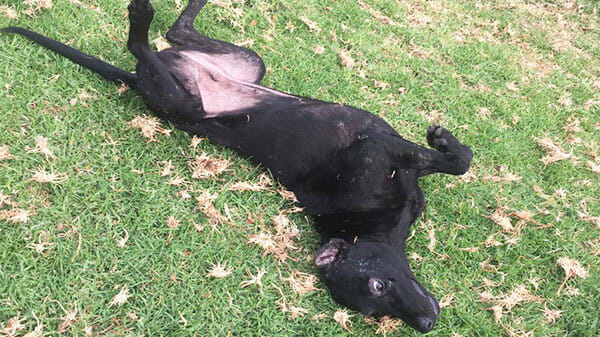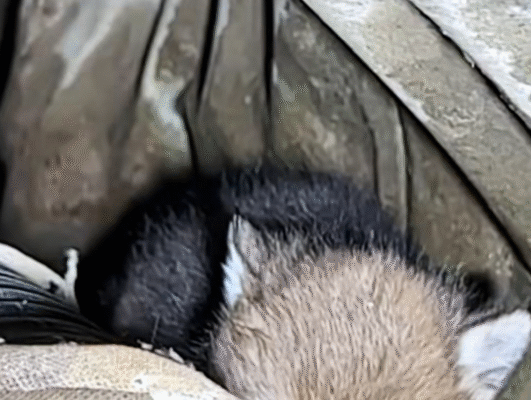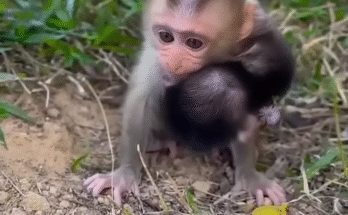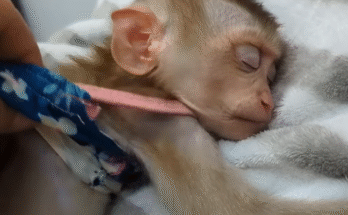It was supposed to be a normal Saturday. I had no big plans—just some yard work, a bit of cleaning, and maybe a walk around the neighborhood trails before dinner. The sun was high and the air smelled like freshly cut grass. Birds chirped in the distance, and my dog, Max, trotted alongside me as I made my way behind the shed to check the old drainage pipe that always clogged up after heavy rain.
As I approached the pipe, Max suddenly stopped. His ears perked up, his body tense. I paused, thinking it was probably a squirrel or maybe a raccoon. But then I heard it—a faint whimpering sound, high-pitched and frightened. Max started sniffing around the pipe entrance, whining and pawing at the grass-covered edge.
I crouched down and brushed aside the overgrowth. That’s when I saw it—two wide, terrified amber eyes staring back at me from inside the pipe. At first, I thought it might be a kitten. But as my eyes adjusted to the darkness, I realized it was something else.
It was a baby fox.

Its fur was a mix of reddish-brown and gray, and its tiny paws were scraped and muddy. It must have slipped inside the pipe during the rainstorm the night before and gotten stuck. The opening was narrow, and the little creature was wedged deep inside, trembling.
I felt a jolt of panic. I didn’t want to scare it more than it already was. I spoke softly, “Hey there, little one. It’s okay. I’m going to help you.”
I ran back to the garage, Max close behind me, and grabbed a flashlight, a small blanket, and a long-handled garden tool. I returned to the pipe and carefully shined the light inside. The fox cub blinked but didn’t move. It was too frightened—or too exhausted—to even struggle.
Gently, I tried using the handle to nudge it forward, but it didn’t help. I didn’t want to hurt it, and I certainly didn’t want to make it panic and wedge itself in tighter. I sat back, heart racing. I needed help.
I called the local wildlife rescue center. A kind-sounding woman named Elise picked up. I explained the situation, and she promised to send someone over right away. “Just stay nearby and keep it calm,” she advised.
So I did. I sat cross-legged on the grass, talking quietly, humming, and occasionally shining the light to make sure the little fox was still okay. Max lay beside me, head resting on his paws, eyes watchful.
About 30 minutes later, a white van pulled into the driveway. A young man and woman stepped out, both wearing green shirts with “Wildlife Rescue Team” printed on them. They introduced themselves as Jake and Mia.
They were calm and professional. Mia knelt beside me while Jake went to get more equipment. She peered into the pipe and whispered, “Poor thing’s so tiny. Maybe five or six weeks old.”
With practiced hands, they slid a narrow flexible pole with a loop gently around the fox’s midsection. It was a slow, careful process. The fox squirmed a little but didn’t cry out. Inch by inch, they coaxed it forward until finally, with a soft tug, Jake pulled the baby fox out into the sunlight.
It looked even smaller in the daylight. Its fur was soaked and matted, and its little ribs showed through its skinny frame. Mia wrapped it carefully in the blanket and cradled it like a newborn.
“He’s dehydrated and cold, but otherwise looks okay,” she said. “We’ll get him checked out, feed him, and keep him warm. He’s lucky you found him when you did.”
I felt a rush of relief and unexpected emotion. Something about that tiny, helpless animal had touched me deeply. “Will he be okay?” I asked.
Mia nodded. “Yes. Once he’s strong enough, we’ll release him back into the wild, hopefully near his family’s territory.”
As they prepared to leave, Jake handed me a small card. “If you’d like, call us in a few weeks. We’ll let you know how he’s doing.”
I watched the van pull away, my heart fuller than it had been in a long time.
Over the next several days, I couldn’t stop thinking about that baby fox. I called the center a week later and spoke to Elise again. She told me they’d named the cub “Pip” and that he was responding well to care—drinking formula, gaining weight, even play-fighting with a stuffed toy they gave him.
Three weeks later, they invited me to visit.
The rescue center was tucked away at the edge of a wooded reserve. I was led into a quiet room where Pip was curled up in a soft nest of blankets. He looked so much healthier—his fur fluffier, his eyes brighter. He blinked up at me, then yawned.
“He remembers your voice,” Elise said with a smile. “Want to try feeding him?”
She handed me a small bottle, and I gently held it out. Pip sniffed it, then latched on eagerly. As he drank, I felt a strange mix of happiness and sadness. I knew he wouldn’t stay here forever. He was meant for the wild. But for now, he was safe.
A month later, I got the call. Pip was ready to return to the wild. The rescue team had found a den not far from where I lived—a safe, forested area where a small fox family had been spotted.
They invited me to the release.
It was early evening when we gathered at the edge of the woods. Pip, now stronger and alert, stepped cautiously out of his crate. He paused, sniffed the air, and then darted into the underbrush with surprising speed. A rustle of leaves, and he was gone.
I stood there for a moment, feeling both proud and a little wistful. Pip would live the life he was meant to, wild and free. But I would always remember the day I found him—stuck in that pipe, scared and alone.
Sometimes, the smallest lives remind us just how important it is to care, to act, and to be gentle with the world around us.
And maybe—just maybe—that’s how we make the world a better place. One rescued fox at a time.



